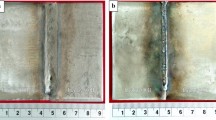Abstract
The stable K-TIG butt welding of 3-mm-thick 10MnNiCr steel plates was achieved with the welding speed of 650–700 mm/min and the welding current of 355–370 A. The keyhole behaviours and stability were investigated by industrial cameras; it was found that the size of the keyhole outlet has an essential relationship with the stability of the keyhole. The appropriate outlet length of a stable keyhole is 5–7 mm. The microstructure and the mechanical properties of the welded joint were studied. The weld structures are dominated by granular and striped bainite. The structures in the superheated zone contain granular bainite, striped bainite, and retained austenite. The recrystallization and the incomplete crystallization zone structures are mainly lamellar and granular pearlite. The tensile samples of the welded joint broke in the base metal area, which indicates the K-TIG welded joint is qualified.













Similar content being viewed by others
References
Salkin JT, Beedon KW, Henon BK et al (2004) Welding handbook, 9th edn. American Welding Society, Miami
Hojny M (2013) Thermo-mechanical model of a TIG welding process for the aircraft industry. Arch Metall Mater 58(4):1125–1130
Jarvis BL (2001) Keyhole gas tungsten arc welding: a new process variant. University of Wollongong
Jarvis BL, Ahmed NU (2000) Development of keyhole mode gas tungsten arc welding process. Sci Technol Weld Join 5:1–7
Liu ZM, Fang YX, Cui SL et al (2017) Keyhole thermal behavior in GTAW welding process. Int J Therm Sci 114:352–362
Lathabai S, Jarvis BL, Barton KJ (2001) Comparison of keyhole and conventional gas tungsten arc welds in commercially pure titanium. Mat Sci Eng A-Struct 299(1):81–93
Lathabai S, Jarvis BL, Barton KJ (2008) Keyhole gas tungsten arc welding of commercially pure zirconium. Sci Technol Weld Join 13(6):573–581
Feng YQ, Luo Z, Liu ZM et al (2015) Keyhole gas tungsten arc welding of AISI 316L stainless steel. Mater Des 85:24–31
Rosellini C, Jarvis L (2009) The keyhole TIG welding process: a valid alternative for valuable metal joints. Weld Int 23(8):616–621
Liu ZM, Cui SL, Luo Z et al (2016) Plasma arc welding: process variants and its recent developments of sensing, controlling and modeling. J Manuf Proc 23:315–327
Liu ZM, Fang YX, Cui SL et al (2016) Stable keyhole welding process with K-TIG. J Mater Process Technol 238:65–72
Cui SL, Liu ZM, Fang YX et al (2017) Keyhole process in K-TIG welding on 4 mm thick 304 stainless steel. J Mater Process Tech 243:217–228
Lancaster JF (1984) The physics of welding. Phys Technol 15(2):73–79
Liu ZM, Fang YX, Qiu JY et al (2017) Stabilization of weld pool through jet flow argon gas backing in C-Mn steel keyhole TIG welding. J Mater Process Tech 250:132–143
Martikainen J (1995) Conditions for achieving high-quality welds in the plasma-arc keyhole welding of structural steels. J Mater Process Tech 52:68–75
Zhang YM, Zhang SB (1999) Observation of the keyhole during plasma arc welding. Weld J 78:53s–58s
Wu CS, Jia CB, Chen MA (2010) A control system for keyhole plasma arc welding of stainless steel with medium thickness. Weld J 89:225s–231s
Liu ZM, Wu CS, Gao J (2013) Vision-based observation of keyhole geometry in plasma arc welding. Int J Therm Sci 63:38–45
Liu ZM, Wu CS, Chen MA (2014) Experimental sensing of the keyhole exit deviation from the torch axis in plasma arc welding. Int J Adv Manuf Technol 71(5–8):1209–1219
Funding
This work was supported by the Open Project Program of the State Key Laboratory of Metal Material for Marine Equipment and Application [grant number SKLMEA-K202005].
Author information
Authors and Affiliations
Corresponding authors
Ethics declarations
Conflict of interest
The authors declare no competing interests.
Additional information
Publisher’s note
Springer Nature remains neutral with regard to jurisdictional claims in published maps and institutional affiliations.
Recommended for publication by Commission XII - Arc Welding Processes and Production Systems
Rights and permissions
About this article
Cite this article
Cai, X., Dong, B., Lin, S. et al. Keyhole TIG welding of 3-mm-thick 10MnNiCr steel plates. Weld World 66, 1349–1356 (2022). https://doi.org/10.1007/s40194-022-01271-y
Received:
Accepted:
Published:
Issue Date:
DOI: https://doi.org/10.1007/s40194-022-01271-y




